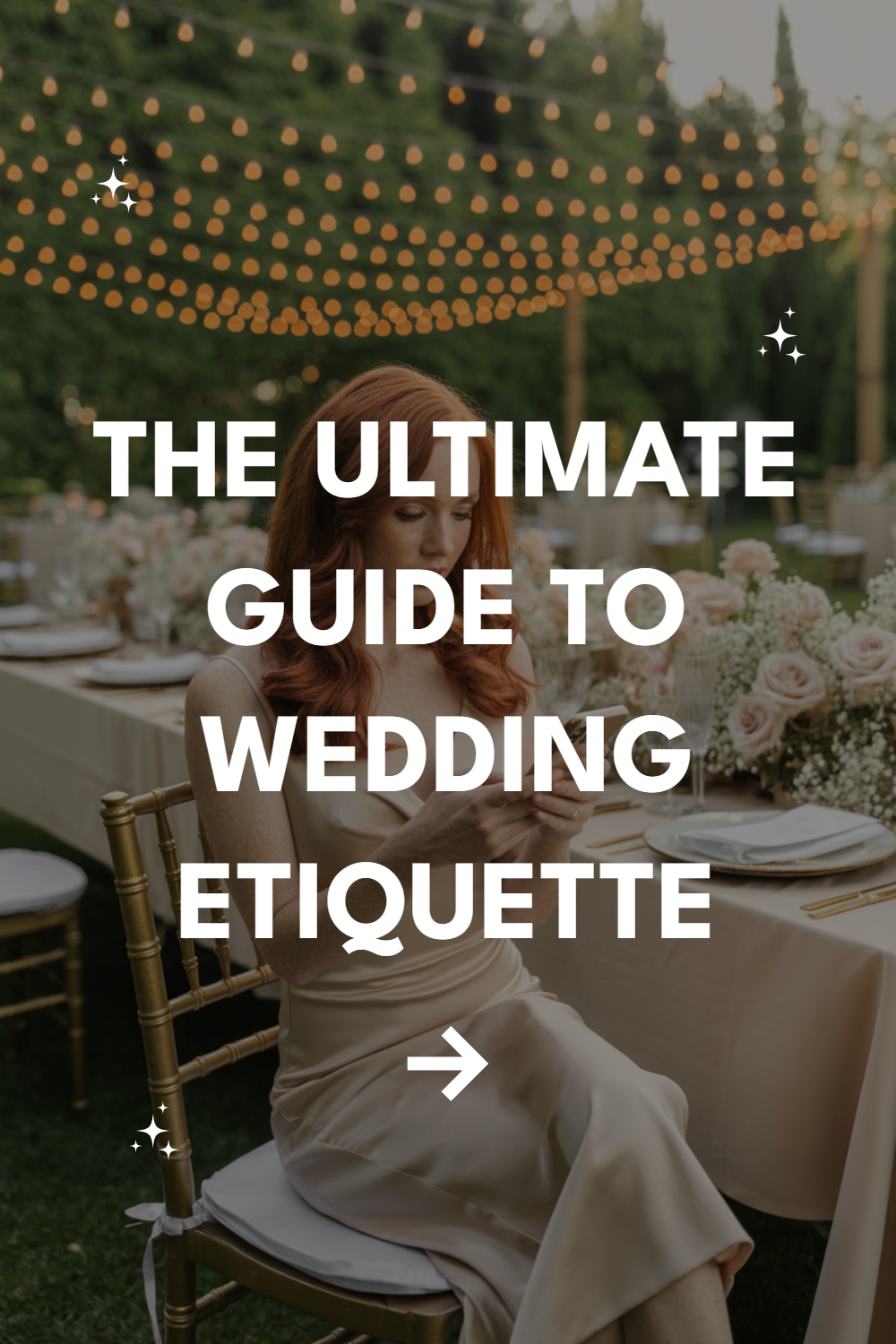Wedding etiquette isn’t about following stuffy rules from your grandmother’s era. It’s about showing respect, avoiding drama, and making sure everyone feels included in your celebration.
Let’s dive into the essentials that actually matter in today’s wedding world.
Pre-Wedding Planning Etiquette
Engagement Announcements and Save the Dates
Breaking the news about your engagement should follow a natural hierarchy. Parents and immediate family deserve to hear directly from you before they see it splashed across social media.
Close friends and extended family come next, followed by your broader social circle. This prevents hurt feelings and awkward conversations later.
Save the dates should go out six to eight months before your wedding, especially for destination weddings. Include essential information like the city and date, but skip the flowery details—that’s what invitations are for.
Digital save the dates are perfectly acceptable now, though some older relatives might appreciate a physical card. Consider your guest list demographics when making this choice.
Guest List Boundaries
Creating your guest list will test every relationship you have. Start with your must-have people, then work outward based on your budget and venue capacity.
The “plus-one” question causes more stress than choosing a wedding dress. Married couples, long-term partners, and wedding party members automatically get plus-ones. Single guests at weddings where they won’t know many people should also receive them.
Don’t feel obligated to invite everyone who invited you to their wedding. Relationships change, and your wedding isn’t a debt repayment plan.
Children at weddings remain a contentious topic. Decide early whether you want an adults-only celebration and communicate this clearly on your invitations.
Wedding Party Expectations
Choosing your wedding party should be about honoring your closest relationships, not evening out numbers or avoiding hurt feelings. Uneven sides look perfectly fine in photos and during the ceremony.
Be upfront about financial expectations from the start. Bridesmaids and groomsmen typically pay for their own attire, but you should cover any specific accessories or styling requirements you insist upon.
Bachelor and bachelorette parties have evolved beyond single nights of debauchery. Weekend trips and elaborate celebrations are common, but not everyone can afford them. Plan inclusively or offer alternative ways to celebrate.
Wedding party members have responsibilities, but they’re not your personal assistants. Delegate tasks reasonably and show appreciation for their efforts.
Invitation and RSVP Etiquette
Proper Invitation Timing and Wording
Wedding invitations should arrive six to eight weeks before your wedding date. This gives guests enough time to make arrangements without letting the date slip from their memory.
Traditional wording has its place, but your invitations should reflect your personality as a couple. Formal ceremonies call for formal language, while casual celebrations can use more relaxed phrasing.
Include all necessary information clearly: date, time, location, dress code, and RSVP details. Guests shouldn’t have to hunt for basic information or make assumptions about your expectations.
Registry information never belongs on wedding invitations. Include it on your wedding website or share it when guests specifically ask.
RSVP Management
Set your RSVP deadline three to four weeks before your wedding. This allows time for follow-up with stragglers and final headcount confirmation with vendors.
Make responding as easy as possible for your guests. Online RSVPs work well for tech-savvy crowds, while traditional response cards suit more formal affairs.
Some guests will inevitably ignore your RSVP deadline. Follow up personally with a phone call or text message rather than assuming they’re not coming.
Dietary restrictions and special accommodations should be addressed on your RSVP cards. This prevents last-minute scrambling with your caterer.
Gift and Registry Etiquette
Registry Guidelines
Create registries at different price points to accommodate various budgets. Include items ranging from under $25 to several hundred dollars.
Traditional registry rules suggested items for setting up a household, but modern couples often already live together. Register for experiences, upgrades to existing items, or contributions toward larger goals.
Completion discounts from retailers let you purchase remaining registry items at reduced prices after your wedding. Take advantage of these programs for items you really wanted.
Multiple registries are acceptable, but don’t go overboard. Two or three well-curated registries work better than spreading thin across many retailers.
Gift-Giving Expectations
Guests have up to one year after your wedding to send a gift, though most arrive before or shortly after the celebration. Send thank-you notes within three months of receiving each gift.
Cash gifts have become increasingly common and acceptable. Many couples prefer monetary contributions toward honeymoons, home purchases, or other goals.
Destination wedding guests who travel significant distances to attend shouldn’t feel pressured to give elaborate gifts. Their presence and travel expenses are gifts enough.
Group gifts from multiple guests work well for larger registry items. Coordinate through the wedding party or close family members to avoid confusion.
Ceremony Etiquette
Processional and Seating Arrangements
Traditional seating puts the bride’s family and friends on the left side, groom’s on the right. However, mixed seating creates a more unified atmosphere and works better when one side significantly outnumbers the other.
Reserve the first few rows for immediate family and VIP guests. Use reserved signs or ask ushers to guide people to appropriate seats.
Divorced parents require careful consideration for seating arrangements. The parent who raised you typically sits in the front row, with the other parent in the second or third row.
Late-arriving guests should be seated quickly and quietly by ushers. Consider having a coordinator manage this to avoid disruptions during the processional.
Ceremony Participation
Unplugged ceremonies have become increasingly popular as couples want professional photos without guests’ phones blocking the view. Announce this preference clearly and consider having your officiant make a brief reminder.
Personal vows should be kept to a reasonable length—two to three minutes each. Longer vows lose impact and test guests’ attention spans.
Unity ceremonies, cultural traditions, and religious elements should feel authentic to your relationship. Don’t include rituals just because they look nice if they don’t hold meaning for you.
Ring bearers and flower girls under age five are adorable but unpredictable. Have backup plans and don’t stress if they steal the show with unexpected antics.
Reception Etiquette
Cocktail Hour and Mingling
Cocktail hour gives you time for photos while guests enjoy drinks and appetizers. Ensure this period doesn’t drag on too long—45 minutes to an hour works well.
Receiving lines have fallen out of favor at many weddings because they create bottlenecks and feel formal. Instead, make rounds during cocktail hour and dinner to greet guests personally.
Signature cocktails add personality to your reception, but always offer wine, beer, and non-alcoholic options. Not everyone drinks, and some guests have dietary restrictions.
Background music during cocktail hour should encourage conversation, not compete with it. Save the dance floor anthems for later in the evening.
Dinner Service and Toasts
Seating charts prevent confusion and ensure compatible groups sit together. Mix friend groups and family members thoughtfully, considering personalities and relationships.
Vendor meals are often overlooked but important to address. Your photographer, DJ, and other vendors working through dinner should receive appropriate meals.
Toast order typically follows this sequence: best man, maid of honor, parents, then the couple. Keep speeches to three to five minutes each to maintain energy and attention.
Open bars are generous but not required. Limited bars, wine and beer only, or signature cocktails with cash bar options work for various budgets.
Dancing and Entertainment
First dance timing matters more than song choice. Schedule it early enough that older guests and children can witness this special moment before they leave.
Parent dances honor family relationships but shouldn’t feel forced. Skip them if family dynamics make these moments uncomfortable rather than meaningful.
DJ requests from guests can derail your carefully planned playlist. Give your DJ guidance about taking requests and trust their experience reading the room.
Last dance provides a natural endpoint to your reception. Choose a song that reflects your relationship and gives remaining guests a final celebration moment.
Thank You and Follow-Up Etiquette
Thank You Note Essentials
Handwritten thank-you notes remain the gold standard for wedding gifts. Printed cards with personal messages work for large guest lists, but avoid completely generic notes.
Mention the specific gift and how you plan to use it in each note. This shows genuine appreciation and proves you opened and acknowledged their thoughtfulness.
Divide thank-you note writing between partners to share the workload. Each person can handle their own family and friends, or split alphabetically.
Photos from your wedding make lovely additions to thank-you notes. Include a favorite shot from the day to help guests remember the celebration.
Post-Wedding Relationship Management
Wedding planning stress can strain relationships with family and friends. Address any conflicts that arose during planning with honest conversations and apologies when appropriate.
Vendor relationships shouldn’t end after your wedding day. Leave reviews for exceptional service and maintain connections with vendors you’d recommend to other couples.
Wedding party appreciation goes beyond thank-you gifts. Check in with these important people after the wedding whirlwind settles and show ongoing gratitude for their support.
Social media sharing should respect guests’ privacy preferences. Ask before posting photos that prominently feature others, and be mindful of tagging people who might prefer privacy.
Navigating Modern Wedding Challenges
Technology and Social Media
Wedding hashtags can unite your celebration across social platforms, but don’t force them if they feel unnatural. Simple combinations of your names and wedding date work better than complicated puns.
Live streaming ceremonies became essential during the pandemic and remains helpful for elderly or distant relatives who cannot travel. Designate someone reliable to manage the technical aspects.
Photo sharing apps let guests contribute their candid shots to your wedding memories. Set these up before your wedding and include access information in welcome bags or on tables.
Professional photography contracts should address social media usage and timeline expectations. Understand when you’ll receive photos and what rights you have to share them.
Budget and Financial Etiquette
Wedding costs have spiraled beyond traditional expectations, but etiquette rules haven’t caught up. Communicate your financial limitations honestly with vendors and family members.
Splitting wedding costs between families requires delicate conversations about expectations and decision-making authority. Establish these boundaries early in planning.
Asking for money instead of gifts has become socially acceptable, especially for couples who already have established households. Frame these requests positively around your goals and dreams.
Budget-friendly alternatives to traditional wedding elements shouldn’t feel apologetic. Brunch receptions, weekday celebrations, and intimate gatherings can be just as meaningful as elaborate affairs.
Final Thoughts on Wedding Etiquette
Wedding etiquette evolves with changing social norms and family structures. The core principle remains constant: treat people with respect and consideration throughout your celebration.
Focus on creating an inclusive, joyful experience rather than perfectly executing every traditional rule. Your guests will remember how you made them feel, not whether your invitation wording followed century-old conventions.


